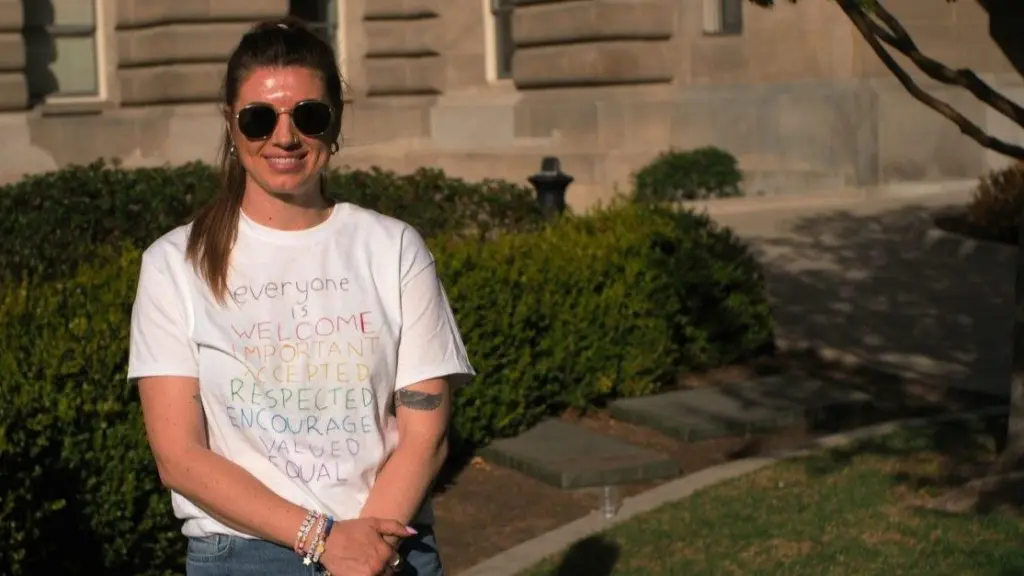Originally posted on IdahoEdNews.org on September 23, 2025
BOISE, ID – It has been a weird year for Sarah Inama.
She went from being a middle school teacher, mom, and history buff to also becoming the unintended leader of a school equity movement that went viral.
Last spring, she went public with her fight to keep an “Everyone is Welcome Here” sign up in her West Ada School District classroom. The sign was meant to create a respectful learning environment and to build rapport with young teens. She bought it at a local craft store.
The school district argued the sign, and the multiracial hands along the bottom, were not tied to curriculum and were not content neutral, and therefore violated district policy.
Inama says she had no intent to be political or cause division among her colleagues and fellow Idahoans, or create a national and polarizing conversation.
But once her story took off, she welcomed the attention and she did not back down. She doubled down. She defied her principal, went to the media, spoke out in public, quit her job and posted her signs to her new classroom in the Boise School District.
Her husband wasn’t surprised.
“She just cares about others to a great extent,” said Adrian Inama. “She’s very selfless. She has a lot of empathy, integrity runs through her blood. She wants to do the right thing all the time.”
Inama’s winding path to an Idaho classroom
Inama, 36, is originally from Chicago but grew up in Boise. She went to North Junior High School, where she now teaches, and graduated from Boise High School.
From there, she went to the University of Idaho, where she intended to major in education.
“I kind of always wanted to be a teacher,” Inama said. “I even took some ed classes in college but I feel like I was persuaded by a handful of people to not be a teacher.”
She was a member of Tri-Delta sorority, studied overseas and participated in model United Nations, which all led her to major in international studies.
But after graduation, Inama wasn’t sure what she wanted to do career-wise. She got a job in human resources at a beer distributor in Boise.
Then her uncle was diagnosed with stage four brain cancer.
“I could tell that they were having a hard time figuring out how to handle that,” Inama said. “I was like, ‘You know what? I’m not tied down by anything.’ So I moved to Chicago and moved in with him and my grandma.”
Inama served as her uncle’s caretaker and worked at a bar in Chicago until his death. In 2018, she moved back to Idaho and knew it was time to pursue her dream of teaching.
She began an online certification program and started substitute teaching in the Boise School District.
She loved history so that subject area seemed perfect and Inama said she always had a soft spot for middle schoolers.
“That middle school, junior high vibe is like they still care about you as a person, they’re not so stubborn, stuck in their ways, but they’re also figuring out who they are as a person and coming into their own,” Inama said.
Inama started teaching world civilization full-time at the start of the 2020-21 school year, and that’s when she first remembers putting up an “Everyone is Welcome Here” sign in her classroom.
She married her husband the next year and they welcomed their son in December 2023.
Adrian Inama said it has always been clear his wife’s students look up to her and respect her.
“She connects with the students really well and I can tell that she truly truly cares about her students,” he said. “I’ve had many late nights sitting up and listening to her talk about how great this student was and how impressed she was by that student.”
Inama remembers the exact day the sign controversy started
It was February 3, 2025.
Her principal came into her classroom at lunch to tell her to take down two signs because they were not “content neutral” and violated district policy. One read, “Everyone is Welcome Here.” The other read, “In this room everyone is: welcome, important, accepted, respected, encouraged, valued, equal.”
As soon as her principal left, Inama recorded a video of the signs and summarized what her principal said to send to her husband and mom.
“I could just tell that she was pretty upset about it,” Adrian Inama said. “When she fully explained it to me, I was just shocked really, I was confused, I didn’t really understand what was going on.”
“I just couldn’t see how those posters could pose a problem for anyone for any reason.”
In the moment, Sarah Inama was mad she was asked to take them down.
“I was raging pissed and then as soon as the bell rang, I’m usually not super emotional but I was like, ‘Oh my god, I’m going to cry,’” Inama said. “Seeing them all walk in, I was just sad.”
Inama had already planned to show a video during class, so she set up her students, then stepped out to compose herself. She took down the signs while the students watched the video.
“I didn’t want to make a big display of it,” she said.
A couple students asked her why she took them down. Inama couldn’t explain, so she didn’t.
“I can’t even, there’s no good reason,” Inama said. “At that point it was like less is more. I kind of was like, ‘I don’t know yet.’”
Over the weekend, Inama took a yoga class that brought clarity.
She walked in her front door and told her husband, “I want to put that sign back up and I want to put it up right now.”
She recalled her husband’s response: “I was hoping you would say that.”
“Knowing her, I was honestly shocked that she took them down in the first place,” Adrian Inama said. “I think it was a knee jerk reaction on her part.”
Inama, her husband, and their toddler went to the school on a Saturday and rehung the signs, and then she typed out an email to her principal.
“I don’t agree with the fact that you are asking me to take down a poster that says that all my students are welcome here unconditionally, because someone may or may not believe that. Why do we even care about someone that doesn’t agree with that? That’s not up for debate,” Inama said, summarizing the email. “That is a staple of public education.”
On Monday, her principal came by and told her the situation was bordering on insubordination. Inama recalls telling him to do what he needed to do, because she wasn’t taking down the sign.
The meeting with her bosses
That’s when Marcus Myers, West Ada’s chief academic officer, got involved. He, along with the principal, had a meeting with Inama.
Inama said she went into detail about how the poster helps her build rapport and motivate her students.
At the start of the school year, Inama has her world civilization students play archeologist in her classroom. They look around and write down what the items in Inama’s classroom tell them about her.
Sometimes it’s her plants or the photos of her family, but often the students gravitate toward posters. The “Everyone is Welcome Here” poster was a common choice. Students would say the poster showed Inama wanted students to feel good and comfortable in her classroom, which Inama said was her goal.
In world civilization, Inama teaches about a variety of cultures and religions and wants to emphasize that it’s a no-judgment zone.
Inama also told Myers she was frustrated that the district was making her take down the signs when no one had complained.
“The fact that you’re siding with someone who doesn’t even exist,” Inama said. “You’re just like preemptively trying to protect yourselves from something that may or may not ever happen.”
Inama also recalls Myers saying that the political environment ebbs and flows, and that something that may once have been appropriate in schools may not be any longer.
“I was like, I don’t disagree with you that there are more people in this political environment that he’s talking about that are outwardly racist and have openly racist comments,” Inama said. “But that doesn’t mean that the values of the school change with that.”
EdNews contacted Myers and passed on Inama’s comments about the meeting and asked if he would like to comment. Myers and West Ada did not respond. But in March, Myers told The Ranch podcast that he wanted to listen to Inama’s perspective and that he wasn’t making the decision alone but with a team of people from the district office.
The language on the sign wasn’t the issue. But the multiracial hands along the bottom of the sign did not have a tie into the curriculum, Myers told The Ranch.
The district was trying to be proactive in aligning to policy, Myers told The Ranch Podcast in March. West Ada Superintendent Derek Bub said on an EdNews’ podcast earlier this month the district was also trying to get ahead of proposed legislation that eventually passed, outlawing signs and posters with political viewpoints.
The meeting ended with Myers saying he would talk to legal counsel and other members of the district team and get back to her, he said on the podcast.
Read a summary of the district’s emails with Inama here.
It took weeks to get an answer, but ultimately the district and its attorney affirmed its earlier decision that the signs needed to come down.
“I was just so mad,” Inama said. “You guys either sound like straight racists yourself or that you’re more interested in protecting people with racist feelings about the children in our school than anything else.”
West Ada said the reason it asked Inama to remove the signs is because they are not considered content-neutral.
Specifically, Myers said the issue was the multicolored letters in “everyone” and the racially diverse hands.
“The text by itself doesn’t allow for interpretation,” he said on the podcast.
The sentiments that all students are welcome in school, have a right to be there, and are expected to respect each other, are all core to West Ada’s mission, Myers said.
The fallout from going public
Inama was frustrated with the decision and decided to contact KTVB to tell her story, her one hesitation was she didn’t want her students to know what the district had said.
Middle schoolers are perceptive, Inama said, and they can tell that being required to take down a sign that says “Everyone is Welcome Here” with hands that have different skin tones, is race-related, Inama said.
“We love kids having different opinions, but allowing racist opinions to affect them. I’m sorry but no, thanks,” Inama said.
Still in March, she went public.
That same month, Niki Scheppers, West Ada’s chief of staff and communications, addressed concerns that the request to remove the signs could be considered racist, or could imply that students of color are not welcome in classrooms.
“West Ada School District is committed to ensuring that every student feels safe, supported, and valued in our schools,” Scheppers wrote in an email to EdNews. “The request to remove specific signage is not about excluding or marginalizing any group of students. Our policies are in place to maintain a neutral educational environment while upholding our commitment to inclusion, respect, and belonging for all.”
All students are still welcome in West Ada Bub emphasized, earlier this month.
“Every person that walks through the thresholds of our doors is welcome in our schools. We are excited to have whoever it is. We teach every type of student. We teach challenges, no challenges, whatever it might be,” Bub said. “We get to welcome them into our schools every single day.”
The district learned from the situation, Bub said, pointing to a new grievance process outlined in an updated version of the sign policy.
Bub and the district are doubling down that the “Everyone is Welcome Here” sign isn’t classroom appropriate.
The proposed legislation that sparked the policy, passed and became law in July.
This summer Idaho Attorney General Raúl Labrador’s office wrote in an opinion that the “Everyone is Welcome Here” sign is political and therefore not allowed in Idaho classrooms, a point of vindication claimed by Bub and West Ada.
The district will follow Labrador’s opinion, unlike nearby Boise, which is allowing the signs to remain up.
Inama’s only regret
Before the story finished airing in March, Inama was already getting emails, largely of support.
She began receiving piles of letters from a wide variety of people, veterans, holocaust survivors, the author of the “Max and Ruby” books sent her a personalized painting of the characters with an “Everyone is Welcome in this Classroom” sign.
“Being around something like this it kind of takes over everything,” Adrian Inama said. “It’s been pretty inspiring to see how she has handled this and also always been there for myself and our son.”
Many online commenters questioned Inama’s political agenda. Inama maintains she would never share political views in class.
“These kids don’t know my religious beliefs, even though they ask me sometimes, because we talk about religion,” Inama said. “They do not know my political beliefs… the election happened in the middle of the school year, and we never talked about it in class. They don’t know my political stance.”
Inama said she felt her signs were a key part of public education.
“They can tell me their political beliefs if they want to. They can wear it. They can be proud of it, but that’s separate from how you treat other human beings with dignity and respect, especially in a public school classroom,” Inama said. “It’s universal that you can’t come into a classroom and bully, harass, hurt another student, physically or emotionally.”
Inama said she was surprised West Ada didn’t fire her. She chose to leave for the Boise School District, where administrators wore “Everyone is Welcome Here” shirts shortly after the controversy and allowed her to put up her sign.
“It’s just a night-and-day difference,” Inama said.
Her goal remains the same, to create a comfortable space for students to learn.
“My intention and my drive for this whole thing has been about nothing other than making sure all my students are treated equally and feel like they deserve to hold the same amount of space,” Inama said.
Looking back, Inama said she has only one regret about the sign that thrust her into a viral national story: “that I took it down in the first place.”





